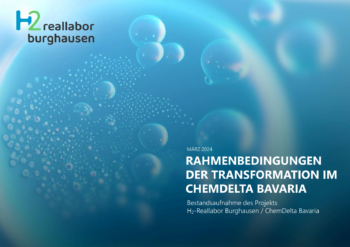Series of articles Carbon Management: CCS – How can CO2 be stored?
With the European climate neutrality targets for 2050 firmly in place, carbon management is moving into the focus of sustainable environmental practices. The challenge is not only to reduce emissions, but also to effectively manage unavoidable emissions. This requires the use of carbon capture technologies that enable either underground storage (Carbon Capture and Storage – CCS) or integration into a closed carbon cycle (Carbon Capture and Utilization – CCU). This series of articles provides an overview of carbon capture technologies, possible utilization of CO2, storage methods, transportation options and political efforts in the context of carbon management.
Contents of the article series

Geological formations for the storage of CO2
Various geological formations are suitable for underground storage of CO2 (see Figure 1). The most efficient method of CO2 storage takes place in pore storages at a depth of at least 800 m. Due to the pressure and temperature conditions at this depth, CO2 is in a supercritical state with high density. The use of depleted natural gas and oil fields is particularly suitable, as their cap layers have proven to retain gases and liquids for millions of years. The geology of these fields is also well researched. Given the fact that many oil and gas fields are nearing the end of their economic life, depleted fields offer a promising opportunity for CO2 storage. In oil fields, for example, CO2 can be stored using the Enhanced Oil Recovery (EOR) process. Here, CO2 is injected into oil fields to improve oil production shortly before the end of production. A portion of the injected CO2 remains in the field, making this process also usable for CO2 storage. EOR is already being used commercially, especially in the USA. However, it should be noted that the extraction and subsequent combustion of the extracted oil leads to further CO2 emissions. So far, there are no practical experiences with the so-called Enhanced Gas Recovery (EGR). However, previous studies suggest that gas production can also be improved by injecting CO2. The prevention of unwanted mixing of natural gas and CO2 is still a subject of research. The storage potential in depleted oil and gas fields in Europe is estimated at approximately 25 Gt CO2 [1].
Another option for underground storage are deep saline aquifers. These represent the largest CO2 storage potential in Europe, with approximately 500 Gt CO2 [1]. For comparison: The CO2 emissions in Europe in 2021 were just under 3 Gt. The technical and economic feasibility of CO2 storage in saline aquifers has already been demonstrated in several large-scale commercial projects at various locations worldwide. To use the deep saline aquifers as CO2 storage, they must have a dense covering rock layer to prevent migration of the CO2 upwards.
The storage potentials for Europe according to [1] are plotted in Figure 2 in comparison to the cumulative storage requirement according to the EU Reference Scenario 2020 [2]. According to this scenario, the European storage potentials would be exhausted in about 340 years.

To ensure that there is temporal flexibility between the provision and acceptance of the captured CO2 for further use (see article “CCU – How can CO2 be utilised?”), additional buffer storage may be required. Here, both saline aquifers, above-ground storage devices, and to a lesser extent the storage potential of the pipeline network can provide a solution. When CO2 is reused in basic chemistry, for example for the production of plastics, these plastics simultaneously act as temporary CO2 storage during their lifespan.
Trapping mechanisms and leakage risks in geological storages
To ensure the safe storage of CO2, it must remain underground for a long time and ideally without leaks. A combination of physical and chemical trapping mechanisms retain the CO2 in pore storages such as saline aquifers and depleted oil and gas fields. These are effective to varying degrees over different time intervals, as can be seen in Figure 3 [3].

- Structural Trapping: Since CO2 has a lower density than water after injection, the rise of CO2 must be restrained by rock structures. This is usually done by barrier rocks, such as clay or salt, thus forming the predominant retention mechanism in the first years of storage.
- Residual Gas Trapping: Capillary forces hold the CO2 when the pore spaces in the storage rock are so narrow that the CO2 can no longer rise despite the density difference to the surrounding water. This phase primarily occurs during the rise of the CO2.
- Solubility Trapping: Over time, some of the CO2 dissolves in the saline water of the storage rock. The solution is heavier than the surrounding formation water, resulting in a downward movement.
- Mineral Trapping: After about 100 years, the CO2 can react with rock-forming minerals, causing the CO2 to crystallize. Mineral trapping is generally considered the most stable and safest of the four mechanisms, but it is very slow in typical sedimentary rocks and extends over periods of centuries and millennia.
Despite the these trapping mechanisms, a leakage of CO2 through boreholes and along geological faults is possible. Therefore, the potential for leakage depends on the integrity of boreholes, cap rock, and overburden [9]. Alcalde et al [4] model the leackage risks for storage sites. For well-regulated storage sites they calculate leakage rates of 0.00005% to 0.003% per year, which decrease over the storage duration. In this scenario, 98% of CO2 still remains in the storage site after 10000 years. The leakage rate is thus in a significantly lower range than the acceptable leakage rate of approximately 0.01% per year indicated by stakeholders. In a worst-case scenario with poor regulation of the storage sites the calculation show that only 78% of the stored CO2 remains in the reservoir after 10000 years [4].
Costs for geological storage of CO2
The costs for storing CO2 depend on the geological formation (depleted gas and oil fields or saline aquifers), as well as site-specific conditions. Since the existing infrastructure for depleted oil and gas fields can potentially be used for CCS applications, some studies expect lower costs compared to storage in saline aquifers [5]. Emerging costs for integrity testing could counteract this. In general, storage in offshore areas is estimated to be more expensive than onshore [6]. The costs for onshore storage of CO2 amount to about 7.6 €/t at a storage rate of 6 Mt/a (corresponds to a slightly higher storage rate than plans in the pilot project Northern Lights). To ensure safe operation without leaks, monitoring of the storage facility is also necessary. The associated costs amount to about 6.7 € per ton of CO2 (base year 2023) [6]. For offshore storage, costs of 8-19€ per ton of CO2 are incurred [5].
Competition for the utilization as hydrogen storage
In the course of the energy transition, hydrogen will continue to gain importance. Due to the fluctuating production from renewable energies and a seasonal dependence of the hydrogen demand, large storage needs for hydrogen are expected. Both cavern storage and pore storage are considered for storage. The use of pore storage, such as saline aquifers and depleted gas and oil fields for CO2 storage, is thus in competition with the use as hydrogen storage. Due to technical challenges posed by possible physical-chemical and biochemical interactions in aquifers, storage in salt caverns is, from a geological and economic point of view, the more promising type of storage for hydrogen, so potentials should be used here first [7].
Planned and existing pilot projects
The only CO2 storage project in Germany took place at the pilot site Ketzin west of Berlin, where about 67000 tons of CO2 were stored in a saline aquifer from June 2008 to August 2013. The Norwegian Sleipner project has been carrying out large-scale CO2 storage since 1996. The current major Norwegian project “Northern Lights” is expected to be the first project on an industrial scale to cover the entire CCS process chain – CO2 capture, CO2 transport, and CO2 storage. In addition to Northern Lights, numerous other CO2 transport and storage projects are listed as “Project of Common Interest” (PCI) [8], such as Aramis, Norne, Pycasso, and ECO2CEE (successor to EU CCS Interconnector). By being classified as PCI, they receive special support, facilitated access to funding, and accelerated approval procedures.
Literature
[1] Anthonson, Karen: EU Geological CO₂ storage summary. Copenhagen: Geological Survey of Denmark and Greenland, 2021.
[2] Capros, Pantelis et al.: EU Reference Scenario 2020 – Energy, transport and GHG emissions – Trends to 2050. Brüssel: European Commission, 2021.
[3] Ismail, Ismail: Carbon Capture, Utilization, and Storage in Saline Aquifers: Subsurface Policies, Development Plans, Well Control Strategies and Optimization Approaches—A Review. In: Clean Technologies 2023, 5, 609–637. Athens, Greece: National Technical University of Athens, 2023. DOI: https://doi.org/10.3390/cleantechnol5020031.
[4] Alcalde, Juan: Estimating geological CO2 storage security to deliver on climate mitigation. In: NATURE COMMUNICATIONS (2018)9:2201. Aberdeen: University of Aberdeen, 2018. DOI: 10.1038/s41467-018-04423-1.
[5] The Costs of CO2 Storage – Post-demonstration CCS in the EU. Brussels, Belgium: European Technology Platform for Zero Emission Fossil Fuel Power Plants, 2009.
[6] Smith, Erin: The cost of CO2 transport and storage in global integrated assessment modeling. In: International Journal of Greenhouse Gas Control Volume 109, July 2021, 103367. Cambridge, MA, USA: Massachusetts Institute of Technology, 2021.
[7] Warnecke, Matthias: Untertägige Speicherung von Wasserstoff – Status quo. Berlin: Bundesanstalt für Geowissenschaften und Rohstoffe (BGR), 2021.
[8] THE UNION LIST OF PROJECTS OF COMMON INTEREST AND PROJECTS OF MUTUAL INTEREST (‘UNION LIST’) (Annex PCI PMI list). Ausgefertigt am 2023-11-28, Version vom 2023-12-28; Brussels – Belgium: European Commission, 2023.
[9] Geologische CO2-Speicherung – was ist das eigentlich?. Hannover: CO2GeoNet, 2009. ISBN: 978-2 -7159-2456-7.

